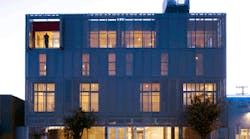HOLLYWOOD, CALIF. — Cherokee Lofts, just completed this May in Southern California, is a five-story, mixed-use building that is 40% more energy efficient than California Title 24. Designed with passive strategies and a photovoltaic system, the mixed-use building is utilizing an advanced variable refrigerant flow (VRF) cooling and heating system and water conserving plumbing fixtures.
The mixed-use building, which pays homage to the Hollywood history of Cherokee Recording Studios, MGM Studios and the many musicians who recorded music at this location, consists of 12 market-rate lofts, 2,800-sq.ft. of retail space, one underground level of parking, and a rooftop deck and green roof. It is the first U.S. Green Building Council LEED Platinum pending mixed-use building in Hollywood, Calif.
Energy conservation
In addition to an efficient building envelope, based on passive design strategies, Mitsubishi’s Advanced VRF Cooling and Heating Comfort System was installed, which acts as a heat pump, moving heat from one part of the building to another. As a result, the building’s heating and cooling loads are reduced by nearly 50%.
“It is important to incorporate an integrated design process when building green,” explained Greg Reitz, the project’s developer and founder and principal of REthink Development, a real estate development and consulting company focused on leveraging green building practices and high performance building technologies to build environmentally sound communities and workplaces. “The mechanical systems can only be selected in the context of how the overall building is designed to be energy efficient.”
According to the project’s architect, Lawrence Scarpa, principal of Brooks + Scarpa (formerly Pugh + Scarpa) Architects, Santa Monica, Calif., the Advanced VRF Cooling and Heating Comfort System by Mitsubishi, which was also used in Canada’s new 2010 Olympic Village, cools and warms the floors, ceilings and walls to create perfectly temperate environments better for respiratory systems, skin, overall heat, comfort and energy efficiency.
“The Advanced VRF Cooling and Heating Comfort System was implemented for this project because it provided a high level of energy efficiency, but at the same time maximum comfort and control,” explained Albert Bicol, partner of Cobalt Engineering, Vancouver, British Columbia, the project’s mechanical engineering consultant. “This system is also very flexible in its configuration and components. There are several types of indoor fan coil units and diffuser types to choose from. Individual meters are also quite easy and in most instances built into the control system. This is ideal for a mixed-use building.”
For this project, it was imperative that the HVAC in the retail and residential portions of the building be integrated.
“We wanted to do that [integrate the retail and residential HVAC] so that we could make use of any heat rejection from the retail space in the residential,” explained Bicol. “But then how to meter? The plan is to use the software built into the CityMulti controls system to summarize the usage of heating/cooling at each fan-coil unit. That data could then be used to divvy up the power bills for the units between each suite, residential and commercial.”
Scarpa told CONTRACTOR that the HVAC is highly unusual in that it uses a single variable drive system for all of the units, rather than individual package units for each dwelling.
“One of the side benefits of this, in addition to being more efficient, is that it gave us more space for the green roof,” said Scarpa. “You don’t see the clutter of a dozen air-conditioning package units you would normally see on a condo building roof.”
Besides saving energy via an efficient HVAC system and building envelope, a 30 kW solar PV system by Kyocera is designed to provide 11.5% of the building’s energy needs, powering the common area electrical loads for the building.
According to Bicol, a solar PV system was chosen as an alternative energy source for the building since it was a perfect fit for an all-electric HVAC system and there are incentives provided by the state for solar.
“It was determined the most optimal way to go was to power common building systems off the panels (such as security, elevator, exterior and parking lighting, etc.),” explained Scarpa. “In addition to being more affordable, it also freed up common roof space for a green roof that all the occupants can enjoy.”
Water conservation
A variety of water-efficient products were installed in the mixed-use building, including dual-flush toilets by Toto and plumbing bathroom fixtures by Hans Grohe. Bathtubs, sinks and kitchen faucets by American Standard, Kohler, Bobrick, Grohe, Chicago Faucets and Delta were also installed throughout the building. Plus, tankless water heaters by Noritz were chosen to supply domestic hot water.
“Toto fixtures matched high-quality design with high water-efficiency performance,” said Reitz. “Hans Grohe met our water efficiency goals while providing a stylish and recognizable brand.”
Another water-efficient feature is all stormwater runoff is collected in an underground retention basin located in the public right-of-way, which is a first in the city of Los Angeles. The building’s green roof also reduces stormwater runoff and landscaping is low-water and drought resistant.
“We did not have too many challenges in designing the plumbing and water conserving system,” said Bicol. “We feel that it should be just common practice to provide water conserving plumbing systems for all projects.”
“My company was founded only to develop environmentally friendly projects,” said Reitz. “Therefore, there was never a consideration of not incorporating water and energy efficiency. From our experience we know that a high level of green building can be achieved with little additional cost. The payback on the small additional investment is easily demonstrated. For this reason, there is no reason not to go green.”
Besides pending U.S. Green Building Council Platinum certification, the building may also receive certification from the Living Building Challenge, a program launched and operated by the Cascadia Region Green Building Council, a chapter of both the U.S. Green Building Council and Canada Green Building Council. The Living Building Challenge is the most advanced green building rating system in the world.
“We’re hopeful the building will meet this challenge, but that is a long process that involves years of post-occupancy evaluation,” said Scarpa.


